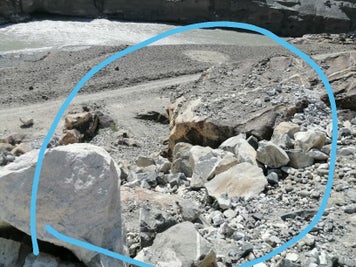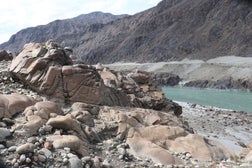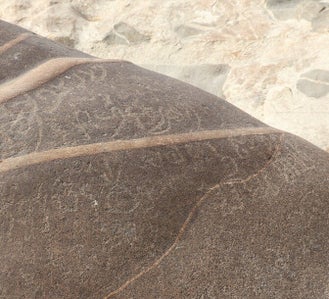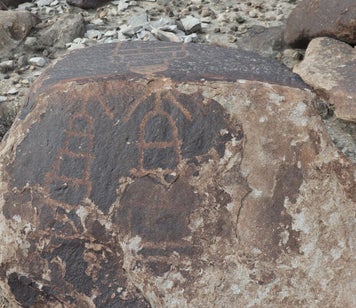Led by project coordinator Abdul Ghani Khan, our team in Gilgit-Baltistan is currently conducting their Karakorum Heritage research, supported by the Prince Claus Heritage Emergency Grant and the Aliph Alliance, for the documentation of ancient rock art in the Karakorum mountain range of the Pakistani Himalayas.
This fieldwork is entirely non-evasive and conducted in collaboration with and as educational initiative for the
region's local communities. On this site, we regularly share updates, with photos, videos and reports.
NEW RESCUE CAMPAIGN AUTUMN 2022
Our team led by Abdul Ghani Khan has started a second campaign in the Karakorum mountains to document ancient rock art. Unfortunately, this year's fieldwork has met with many obstacles. Pakistan is currently deeply affected by flooding, which makes accessibility difficult, and mudslides also threaten sites.
The human cost of this natural disaster across Pakistan has been terrible. We refer those who wish to donate to relief initiatives to the UNHCR aid program.
In addition to these natural threats, the team discovered that the Alam Bridge A site, which we documented in April 2021, has been destroyed due to construction and road works. The sign erected by the team and local authorities last year that marked the site as archaeological heritage has also been removed. The boulders have been bulldozered and destroyed, and nothing is left of the ancient inscriptions, prehistoric hunting scenes, and the Buddhist stupa and symbolic carvings at this site - except for the photographs and digitization of them in our upcoming Open Access catalogue.


Our team and local authorities with the heritage sign post that they erected at the Alam Bridge site in 2021, which is now missing.
The current state of the Alam Bridge A site, September 2022. The boulders are destroyed because of road and construction works
The images below show addition damage to the boulders: some have been entirely destroyed, others badly damaged due to the dumping of road work debris. The surface of many boulders has been scraped off due to them being rolled down slopes to make way for construction works. In addition, the team has found evidence of illegal looting excavation pits across the site as well.
Our main mission now is to survey the area and locate sites where undocumented rock art can still be recorded. Although photographs and digitization in a catalogue do not replace the actual, tangible heritage, at least they assure that the knowledge is not lost for good.
Via this site and our social media (@archaeologists.connected on instagram) we will keep you posted on the developments of this year's rescue campaign.




CARVINGS & COMMUNITY - Academic publication
For more details about our 2021 fieldwork and community outreach in the Karakorum, we can now refer you to this recently published academic article in the Journal of Archaeohistorical Studies (JAHS), Volume 1 Issue 2, November 2021 (pp. 77-90), authored by Marike van Aerde and Abdul Ghani Khan.
The link button will direct you to the PDF file :
Karakorum Vlog Series
Learn more about our research in a new 5-part Vlog series! Visit the series page via the button below and check back weekly for new video entries. All details, credits and uploads are found here:

Our team with the new sign post that they erected at the Chilas site, to mark its importance as archaeological heritage. Meet each team member here.
Report 4: Workshop in Chilas
Abdul Ghani Khan and his team have successfully hosted their educational workshop at Chilas about the ancient rock art of the region and the best ways to protect and document these carvings. Participants from the local community partook in several days of lectures and fieldwork instructions and were awarded a project certificate to mark their status as guardians of the region's archaeological heritage. This involvement of the local community, and the availability of knowledge and education, are crucial for the protection of important archaeological heritage as well as creating new opportunities for the people of the region, to whom the heritage belongs.
The workshop included lectures by Abdul Ghani Khan, Dr. Marike van Aerde, and various of the project's team archaeologists, and was made possible by the Prince Claus Fund and Aliph Alliance. The Archaeology and Museum Department of the Government of Gilgit-Baltisan likewise supported the initiative. Below is a selection of images from the various days of the workshop.




Report 3: From Alam Bridge to Chilas
Our team has with great success completed their survey and documentation of the Alam Bridge site throughout the month of March. During their fieldwork, the team also reached out to the communities of the region. To mark the successful end of the month's work, together with local authorities and the Archaeology department of the Pakistani government, they unveiled an official sign post to mark the historical heritage of the Alam Bridge site.
For the month of April, the now expanded team has moved to Chilas, where they will continue to documented threatened rock art and engage directly with local population during the work an education outreach. More updates will follow soon.
In order to put our talented and hard-working team in the spotlight, we have created an introduction page with more details and professional biographies for each team member. Visit this team page via the link button below.
We also uploaded a brief informative booklet about our Karakorum Project (in the Urdu language), which is free to read on our site and also available for download in PDF format. You will find the document and the download link via the booklet link button below.




Unveiling of the official sign post at the Alam Bridge rock art site, end of March 2021.
Report 2: documenting & connecting
After the initial survey of the Alam Bridge site in Gilgi-Baltistan, our team has made very good progress this second week documenting wide-ranging clusters of ancient rock art, including Buddhist stupas, wild animals, and inscriptions.
Apart from describing and photographing individual carvings, we also document the boulders, their locations and coordinates. We will use these data to map out the routes along which these images were carved by travelers, thousands of years ago.

Abdul Ghani Khan and Zafar Iqbal documenting rock art at Alam Bridge (March 2021)
Alongside these archaeological documentations, one of the most important parts of this project is connecting with the local communities. This week, a group of residents from the region came to visit, and our team invited them for a tour of the site. They explained about our project and shared information about the chronology and historical importance of the numerous rock art of Gilgit-Baltistan. The people were very interested to learn more about the project and have been very encouraging to our team.
We hope that these connections will offer the local communities more knowledge about the rock art and the rich history of their home region, so that they will be guardians of this important Pakistani heritage. Here you can see some images of the meeting. All photos were taken by our team's professional photographer Amjad Ali Mughal.


Our team of archaeologists meets with local residents of the region, and shares information about the project and the ancient rock art ( Alam Bridge, March 2021).
Report 1: The first survey
During this first phase of the survey, our team is at work at the remote location of Alam Bridge in the mountains of Gilgit-Baltistan to document a wide range of ancient rock art and inscriptions. Digital photography and site mapping are important means to ensure that our knowledge of this important archaeological site will be preserved for future generations and made widely available. Despite several cases of vandalism and destruction of carvings at parts of the Alam Bridge site, many petroglyphs here are still accessible and in good condition. Our team is working hard to record them. Below they share some first photos of the site and terrain from this week.





Photography by Abdul Ghani Khan and Zafar Iqbal (01-05 March 2021)
Project Summary
Abdul Ghani Khan (MPhil) will oversee the project in Pakistan, through the coordination of the fieldwork. Importantly, he will also lead the outreach and education program developed with the local communities, including workshops and collaborative initiatives to ensure a sustained heritage protection for the threatened rock art for and by the local population of the region.

Destruction and vandalism of ancient Buddhist rock art (2019-2020).
As the project’s academic advisor, Dr. Marike van Aerde will coordinate the data study and (Open Access) publications of the project’s rock art documentations and subsequent interpretations. In due course, students and/or PhDs may also be able to get involved with analyses, as part of our ongoing research team Routes of Exchange, Roots of Connectivity.
The main current threat to the Karakorum petroglyphs is the building of the Diamer-Basha dam in the near future, which will flood several valleys that contain large numbers of as yet unrecorded/unstudied ancient rock art, and that will likewise force the relocation of many local villagers. In addition, vandalism and destruction of especially ancient Buddhist rock art continue to occur frequently due to lack of available education, prevailing superstitions, and/or looting and the illegal market for ancient materials.

Damaged/looted rock art in situ.

Large-scale vandalism of rock art in the Karakorum.
Our Karakorum heritage project will therefore focus not only on the emergency documentation of the threatened rock art, but will set up a local collaborative educational program that will directly involve the local communities in the role of guardians of the region’s heritage. This program is already in development in collaboration with local governments in the Gilgit-Baltistan region.
- Regular updates about the project will be posted on this website.
- The Prince Claus Fund will publish more details about the project near its completion in 2021. To read more about the program, visit Prince Claus Cultural Emergency Program.
- Click here to access our recent Open Access academic publication about Karakorum rock art at Oxford University (Van Aerde & Mohns & Khan 2020).



